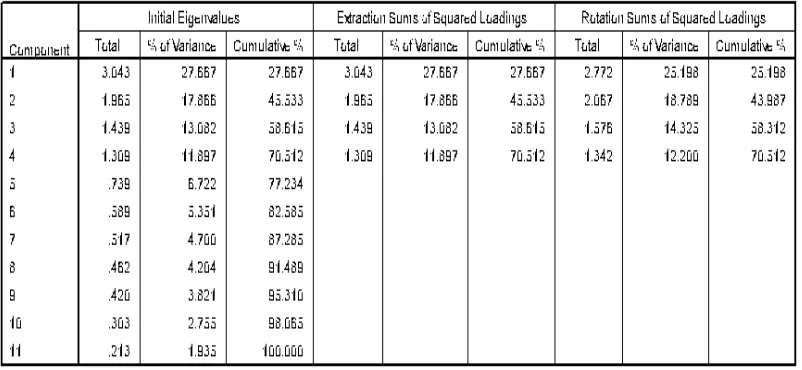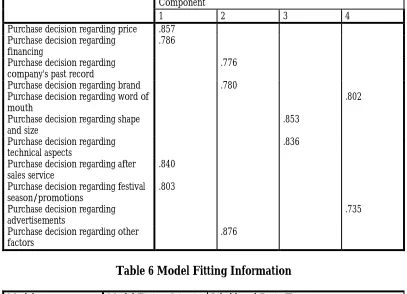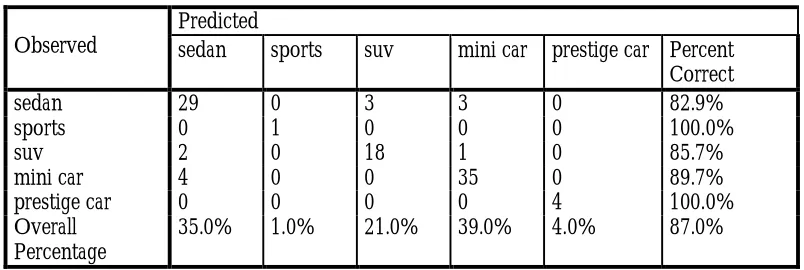ISSN: 2333-6048 (Print), 2333-6056 (Online) Copyright © The Author(s). 2014. All Rights Reserved. Published by American Research Institute for Policy Development
Leveraging Factors for Consumers’ Car Purchase Decisions- A Study in an Emerging Economy
Aindrila Biswas1, Angshu Mukherjee2 and Mousumi Roy2
Abstract
The Indian economy is growing at an unprecedented rate, with high disposable income, easy availability of finance, changes in urban lifestyle fostering car purchase decisions. Indian automobile industry is highly competitive and dynamic owning to major market players from U.S., Germany and Japan. The present study does not only attempt to find the factors behind purchase but at the same time also tries to find out the various other aspects of purchasing, the major dimension or attributes consumers’ prefer to opt for while exhibiting decisions for car purchase. The data for the study has been collected from respondents through the use of structured questionnaires. The five different private car categories used in the study includes- Sedan, SUV, mini-cars, sports cars and prestige cars. Exploratory factor analysis with Multinomial Logit Model has been applied for data analysis. The implications of the research have also been discussed.
Keywords: Automobile industry, SEDAN, SUV, Mini-cars, Prestige car, Sports car
1. Introduction
India is the second most highly populated country in the world with unprecedented economic growth rate fostering demand in the automobile small car segment. India is a major market for leading auto giants. The various reasons swaying the growth of the Indian automobile market being high disposal income, increase in the need of mobility due to urbanization and leisure travel, lenient car financing options offered by the financial institutions, accessibility of service centers and spare – parts at vicinity and amendment in highway infrastructure.
1 Department of Management Studies, National Institute of Technology, Durgapur, India.
Email: baindrila18@yahoo.com
With manufacturers competing to capture one of the fastest growing car markets in the world, the Indian customer is being offered increasingly larger set of cars in various sizes and attributes to choose from. The rapid growth and change scenario, with its potential for affecting local environment and safety, as well as global fuel use and carbon emissions, underscore the need to study this growth and change phenomenon in the country. For the last couple of years, sales figures have shown a shift towards bigger cars (SIAM, 2007). However, the introduction of the affordable mini-car, the Nano by Tata Motors, and the designing of many more affordable small cars by car manufacturers opens up the possibility of a change in the present trend.
For most people, purchasing a car is the second most important decision, so the probability of having a post-purchase dissonance is quite high due to irreversibility of the decision or the high risk perception.
Consumer behavior is fairly complex as car purchase decision involves high level of social, psychological and financial involvement (Shende, 2014). Constant modifications in car models, in terms of features, capacity, styling, mileage etc. has become indispensable. Studying consumer behavior in a highly competitive market and also providing insights into their requirements in a constant dynamic environment is thus necessitated.
The small car market changed very rapidly pertaining to fierce competition, technological advancement, compelling the manufactures to understand consumer preferences on time and take immediate actions to respond to dynamic market.
The Indian consumersare very sensitive towards operating cost since the price of gasoline in India is a large fraction of per capita income. Perception of status in owning a specific personal vehicle, negative image of public and non-motorized modes all play their part in a vehicle choice.
However growing inflation rate, rise in the rate of interest and other government policies are likely to hit the automobile sector hard and thus bring a temporary slowdown for the sector.
The objective of this paper is to identify the major driving factors behind the purchasing decision of cars in the Indian market using a model-based approach.
2.A Brief Literature Review
Several researches have been made with respect to the buying behavior of automobiles in India. The research conducted has not been made with respect to new cars but used cars as well.
However, other researches had emphasized on demographics like family income, gender to be significant predictors of car purchase behavior (Shimpi, 2012). Peers and friends are significant influencers in the purchase decision making of small and mid-sized cars (Clement et.al, 2009). In a study conducted to analyze consumer attitudes towards cars manufactured by European, American or Japanese manufacturers, country-of-origin effect, brand name, distributors’ reputation emerged as significant predictors apart from pricing of passenger cars. Studies found that the general preference was towards mini and compact cars whereas SUVS were also popular among Indian consumers. Sedans and luxury cars were found out to be exclusive and luxury purchases (Srivastava and Tiwari, Shende, 2014).
However the cost and utility conscious consumers were more inclined towards compact and mini cars. Consumers who in general are disinclined towards public transportation system and two wheelers opted for sedan cars more than others. Consumer choice of a particular vehicle of a particular size segment reflects the need in the household and also a preference of the attributes of the specific make and model in the size segment(Banerjee et. al, 2010). Celebrity endorsements by car manufacturers, flexible payment mechanism and effective service delivery packages by dealers and marketing of cars’ safety often leverages car purchase decision (Sharma and Patterson, 1999; K. Vidyavathi, 2005). Mid-sized car-buyers are keen about the space, luxury and comfort (Kotwal, 2009). In a study conducted to assess the influencing factors for consumer brand preference for SUV’s and MUV’s, product reliability, monetary factor, trendy appeal, frequency of non-price promotions offered, trust-worthiness and brand association were identified as the major predictors (Prasanna, 2013).
However the present study differs from the above studies as the sample market here is a representative market of Eastern India. The market due to its nature offers a unique scope of study. At the same time the present study does not only attempt to find the factors behind purchase but at the same time also tries to find out the various other aspects of purchasing such as brand switching.
3. Research Methodology
West Bengal has seen a huge spurt in road density which has resulted in a rise of vehicle ownership also. Also the number of registered motor vehicles in West Bengal is on the higher side among other states.
Data was collected through Face-to-face interviews with the vehicle buyer in their homes or sometimes in their workplaces, with the help of a structured questionnaire. An average interview took 15 minutes. The interviews included questions on the vehicle purchasedecision in the recent future, other vehicles owned etc. Respondents’ attitudes and perceptions were measured on a five-point likert scale.
4. Analysis
4.1. Sample Characteristics
From the Table 1 it is observed that most of the respondents are aged between 20 to 40 years of age. Also it is observed that the major occupation of the interviewed respondents is service that is they are employed salaried persons. At the same time it observed that the income level is mostly between 400000-1200000 INR, which indicates the predominance of the middle class income level in the sample market. Most of the individuals already own a car(76%). Among these individuals Maruti, Tata, and Mahindra and Mahindra are the highest preferred brands showing the preference of consumers towards Indian companies in the automobile market.
4.2. Factor Analysis
The appropriateness of factor analysis can be measured using Barlett’s test of sphericity and Kaiser-Meyer-Olkin (Table 2). The KMO analysis value of 0.686, being greater than 0.60, is considered acceptable for conducting factor analysis (ULCA, 2011). A significant (<0.05) Barlett’s test of sphericity suggests that the resulting matrix is not an identity matrix. Both tests being feasible allow further analysis.
Based on the content definition of factors’ principle and factor weights the following seven factors were identified and re-defined as ‘Pricing regime and after sales’; ‘Brand equity of company’; ‘Technical aspects’ and ‘Effect of Promotional activities’.
In the second phase factor analysis was reused for the variables related to car preference on the set of 12 statements that were administered to respondents. Three factors were deduced explaining 76.96% of the variance with communalities and factor loadings above the threshold value of 0.50. The three factors were thus renamed as ‘Car Dimensions’; ‘Car Reputation’ and ‘Car technical specifications’.
4.3. Model Development using Multinomial Logit Method
Using the factors that were derived using factor analysis and taking into consideration the socio demographic variables we have tried to develop a model that tries to explain this behavior of consumers related to specific car make. Here the Multinomial logit method has been applied to identify the model for each of the car categories with respect to the reference category of mini cars. Multinomial logit model has been applied as the different private car segments are assumed to be distinct and weighed independently in the eyes of consumers. The five different private car segments (Table 1) which a consumer aspires to purchase are distinct alternatives and not mere substitutes. Mini-cars were used as the reference category.The log-likelihood of the intercept measures the total sum of the squares (247.442) and the log-likelihood of the final model measures the sum of the squared errors (77.63) (Table 6). The small log-likelihood ratios thus suggest that the full model is a better fit than the intercept
model. The sufficiently high Pseudo R2 values signify good model fit (Table 7). The
results show us the beta values for each of the car categories (Table 8).
5. Conclusion
Indian consumers are now mainly comprised of the middle class. Their preferences are changing from being only price conscious to checking about car technical specifications as well. Advertisements are too showing an effect on the Indian consumer as promotional offers are altering or effecting purchase decisions as well. Indian consumers are thinking similarly across age and occupation levels.
This should be taken into consideration while segmentation of markets by various companies.Car technical specifications and technology is emerging as an important factor in deciding about the purchase and preference of cars. With the rise of Internet and increased literacy and awareness among consumers, consumers ready to go through the intricate details of the car related to its design,engine etc before taking any major decision. As observed in the multinomial logit analysis the mini car segment is the rising and most dominant section along with sedan segment. However the beta coefficients indicate that most of the car segments will be suffering or will post decreased sales if the factor levels were increased. This is because most of the beta coefficients are negative in nature. However most of the beta coefficients of SUVS are positive indicating a positive trend for SUVS. Thus it can be safely assumed and concluded that SUVs and Mini cars would be the dominant car segments in the future.
6. Implications
Reference
Clement Sudhakar J., and Venkatapathy R. (2009). A Study on Automobile Purchase – Peer Influence in Decision Making. Indian Journal of Marketing, 35 (6) June 2009, p.16 K.Vidyavathi (2012). Customer Life Style Influence of Consumer Behavior with Reference to
Automobile Industry in Chennai, Zenith International Journal of Multi-disciplinary Research, 2(4),pp. 37-50, Apr 2012.
Kotwal, Shapur., (2009), The automobile segment is all poised for steady growth, Auto Focus, The Hindu, pp5, February, 2009
M.Prasanna Mohan Raj, Jishnu Sasikumar, S.Sriram (2013). A Study of Customers Brand Preference in SUVS and MUVS: Effect on Marketing Mix Variables. International Referred Research Journal, 4(1),48-58, Jan 2013
Manish Kumar Srivastava, A.K Tiwari. A Study of Behavior of Maruti SX4 and Honda City Customers in Jaipur. Pacific Business Review- Quarterly Referred Journal
Sharma, N., & Patterson, P.G., (1999). The impact of communication effectiveness and service quality on relationship commitment in consumer, professional services. Journal of Services Marketing, 13(2), 151-70
Shimpi Shriram (2012). A study on consumer buying behavior for used cars in Pune City. Subadra .S., Murugesan.K.M, Ganapathi .R (2010). “Consumer perception and Behaviour : A
study with special reference to Car owners in Namakkal District. APJRBM, 1(3), 37-60, December, 2010
Vikram Shende (2014). Analysis of Research in Consumer Behavior of Automobile Passenger Car Customer. International Journal of Scientific and Research Publications, 4(2), February 2014
UCLA, (2011). Principal Component Analysis. Academic Technology Services.University of California, Los Angeles. Available online:
Table 1: Sample Characteristics
Demographics Frequency (%)
Age (in yrs) 20-30 45
31-40 45
41-50 6
51 and above 4
Occupation Student 24
Self-employed 1
Govt. employee 22
Private employee 37
Others 1
Annual Income (INR) 100000-400000 3
400001-800000 43
800001-1200000 42
Above 1200000 12
Have own cars Yes 76
No 24
Brand of car owned Maruti 32.9
Hyundai 15.8
Tata 21.1
Chevrolet 5.30
Mahindra & Mahindra 17.1
Toyota 5.30
2.60
Type of car consumer wants to buySedan 35
Sports 1
SUV 21
Mini-car 39
Prestige Car 4
Table 2: KMO and Bartlett's Test
Kaiser-Meyer-Olkin Measure of Sampling Adequacy. .686
Bartlett's Test of Sphericity Approx. Chi-Square 325.921
df 55
Table 3: Communalities
Initial Extraction
Purchase decision regarding price 1.000 .795
Purchase decision regarding financing 1.000 .671
Purchase decision regarding company's past record 1.000 .631
Purchase decision regarding brand 1.000 .688
Purchase decision regarding word of mouth 1.000 .686
Purchase decision regarding shape and size 1.000 .744
Purchase decision regarding technical aspects 1.000 .711
Purchase decision regarding after sales service 1.000 .731
Purchase decision regarding festival season/promotions
1.000 .699
Purchase decision regarding advertisements 1.000 .622
Table 5: Rotated Component Matrix
Component
1 2 3 4
Purchase decision regarding price .857
Purchase decision regarding financing
.786
Purchase decision regarding company's past record
.776
Purchase decision regarding brand .780
Purchase decision regarding word of mouth
.802
Purchase decision regarding shape and size
.853
Purchase decision regarding technical aspects
.836
Purchase decision regarding after sales service
.840
Purchase decision regarding festival season/promotions
.803
Purchase decision regarding advertisements
.735
Purchase decision regarding other factors
.876
Table 6 Model Fitting Information
Model Model Fitting Criteria Likelihood Ratio Tests
-2 Log Likelihood Chi-Square df Sig. Intercept Only 247.442
Final 77.630 169.811 40 .000
Table 7: Pseudo R-Square
Cox and Snell .817
Nagelkerke .892
Table 9: Classification
Observed
Predicted
sedan sports suv mini car prestige car Percent Correct
sedan 29 0 3 3 0 82.9%
sports 0 1 0 0 0 100.0%
suv 2 0 18 1 0 85.7%
mini car 4 0 0 35 0 89.7%
prestige car 0 0 0 0 4 100.0%
Overall Percentage



